Translate this page into:
Solar district heating system in Latvia: A case study
⁎Corresponding author. kristina.lebedeva@rtu.lv (Kristina Lebedeva)
-
Received: ,
Accepted: ,
This article was originally published by Elsevier and was migrated to Scientific Scholar after the change of Publisher.
Abstract
The ever growth of urban population has caused the increase of energy demand. This situation challenges the global public to find a way to produce energy in a secure, environmentally friendly, flexible, renewable and sustainable energy transformation system. One of the most promising technologies that can over-come most of the challenges is the district energy network. This paper focuses on best practice project in Latvia – fully renewable district heating system assisted by solar collector system with thermal storage tank and woodchip boilers. The article demonstrates solar impact to district heating system (DHS) in the framework of the current situation of DHS in Latvia by creating simulation in TRNSYS and validation with real system operation data. Real operational data show that the heat produced by solar collector system with thermal energy storage (TES) per year will cover up to 20% (10933,2 MWh) of the heating demand in under local climate conditions. The TRNSYS simulations concluded that the contribution of this type of solar system integrated into the DHS could be increased up to 50%, if the difference between consumption and heat produced by solar collectors were to be increased during the summer months, this could be achieved, for example, by increasing the solar collector field area.
Keywords
Solar thermal energy
District heating systems
Thermal energy storage
Renewable energy sources
1 Introduction
To achieve the objectives set out in the Paris Agreement (Horowitz, 2016), European Union (EU) has set targets for the energy transition to 2030 (Commission, 2030) and 2050 (Commission, 2050), focusing on increasing the use of renewable energy resources (RES), energy efficiency and reducing greenhouse gas emissions. Heating and cooling in buildings and industry accounts for half of the EU’s energy consumption (Tobias Fleiter and Jan Steinbach, 2016). According to Eurostat data, in 2019 75 % of this energy is still generated from fossil fuels and only 19 % - from renewables. Almost 72.5 % of EU-28 inhabitants live in cities, towns and suburbs (“Urban Europe — statistics on cities, towns and suburbs — patterns of urban and city developments, 2023), which means that in order to achieve the set climate goals, a transition to an urban energy system that will not use fossil fuels is needed. It should also be noted that now a very large part of energy is lost due to inefficient heating and cooling systems.
Modern sustainable district heating and cooling systems offer a especial opportunity to make a notable contribution to the decarbonization of EU cities through efficient distribution of heating and cooling from RES. District heating and cooling networks are a proven solution for the large-scale distribution of thermal energy, deployed in a growing number of cities around the world, using an array of technologies that allow synergies to be developed between the generation and distribution of heating, cooling, hot water and electricity (Ignacio, 2020).
The last statistical survey by Euroheat & Power on the district heating and cooling sector reports that about 6000 DH networks were in EU supplying about 11–12 % of the total heat demand in 2017 (Buffa et al., 2019). District heating systems have been proposed as the future of urban heating in Europe. Energy flexibility is very important due to the intermittent nature of renewable energy sources and therefore short-term and long-term energy storage becomes advisable for the system (Halmschlager et al., 2021). The control of fourth generation district heating (4GDH) will not only be focused on the building static heat demand but also on the energy flexibilities, provided, for example, by heat storage capacity. This is used to avoid expensive and inefficient boiler operation at peak load, as well as to use energy flexibility while dynamically optimizing the operation of the energy system using energy carriers.
Currently, the use of renewable energy resources for heating has become one of the main priorities in the design of modern buildings (Gaujena et al., 2015). Of the renewable energy sources, solar energy is often considered to be the most suitable energy source for heating systems (Valancius et al., 2015), and the researches are underway to increase the efficiency of solar thermal systems in order to gradually reduce the use of fossil fuels in heating. In recent decades, large solar assisted DH systems have been rapidly established in European countries, which mainly use for space heating and domestic hot water supply DH systems (Weiss and Spörk-Dür, 2017). More than 70 % of large solar assisted DH systems worldwide have been built in Denmark (Tian, 2019). In the study (Tonhammar, 2014) evaluated the environmental, technical and economic potential of a solar DH installation combined with TES in the Stockholm DH network. In study (Reiter et al., 2016) was suggested a 500,000 m2 solar collector field for 20 % solar fraction connected to DH in Graz (Austria). Simulation results (Urbaneck, 2015) show that the integration of solar collector field with TES in conventional DH systems can be reached easily a solar fraction of about 10 % from technical and economic points of view in East Germany. Hassine and Eicker (2013) proposed the new DH system model with extended solar collector’s field and TES (based on existing town DH system) for 100 % solar fraction during the summer in Ostfildern (Germany). Based on literature review of several studies on solar assisted district heating systems that try to optimize collector field and storage size, seasonal TES were noted to have high potential in regions with high-energy consumption for heating purposes. Due to the fact that most renewable energy sources depend on seasonal or diurnal fluctuations, TES technologies will significantly increase the full use of the potential of district heating systems.
2 Existing case study description
Promoting the energy efficiency and RES use in DHS networks is a major step for performing Latvia's national climate and energy goals and for transition to 4GDH. Many projects related to this have already been implemented. One of them is the connection of solar collectors to the district heating system in Salaspils (see Fig. 1).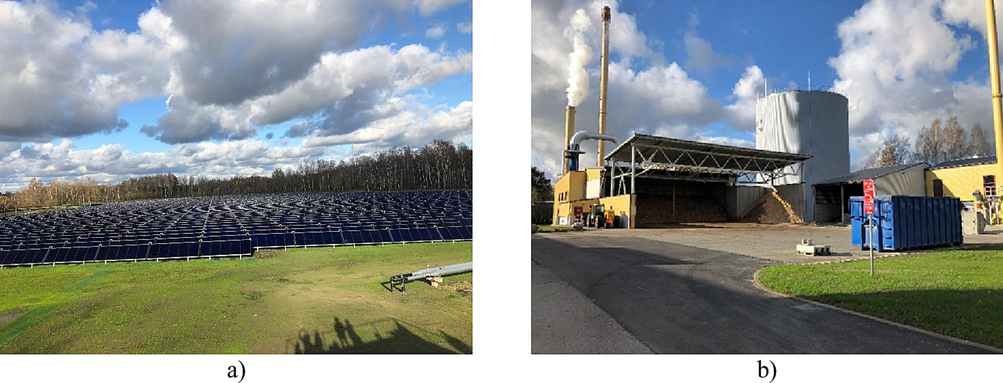
Solar collectors’ system (a) with TES and woodchip boilers (b).
The first solar district heating system in Latvia started in Salaspils in 2019 (see Fig. 2). The project backed by EU, developed by LTD Filter, the Baltic energy solution specialist, and Arcon-Sunmark, the Danish solar heating specialist. The solar collector field covers more than 21,672 m2 (12.8 MW) and consists of 1720 solar collectors. Operational temperature regime: of DH network - flow temperature 90°, return temperature − 60 °C and of solar collector system 45 °C/63 °C. Solar collectors: absorber efficiency about 83 %; orientation South side, 42.5°, heat carrier: water and glycol mixture 30 %. TES parameters: 8000 m3, diameter 20.2 m, height 27.8 m and 200 mm insulation layer mineral wool. The plant is the largest large-scale solar district heating system in Eastern Europe. The solar heating system is a part of the main district heating equipment in Salaspils. The main heating source is two wood chip boilers: 7 MW with 1.68 MW flue gas condensing economizer; 3 MW with 0.5 MW flue gas condensing economizer and 3 (two of them 10 MW and one 3 MW) gas boilers to cover peak loads.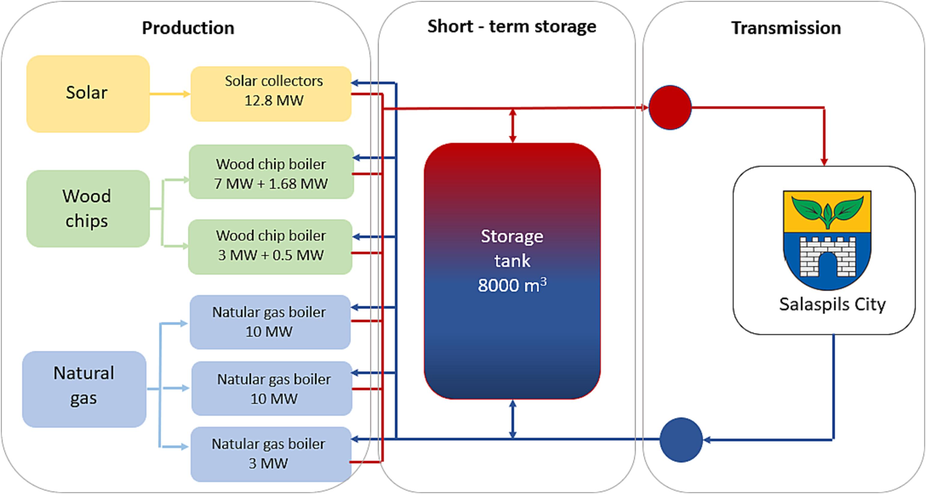
Case study scheme (Polikarpova et al., 2021).
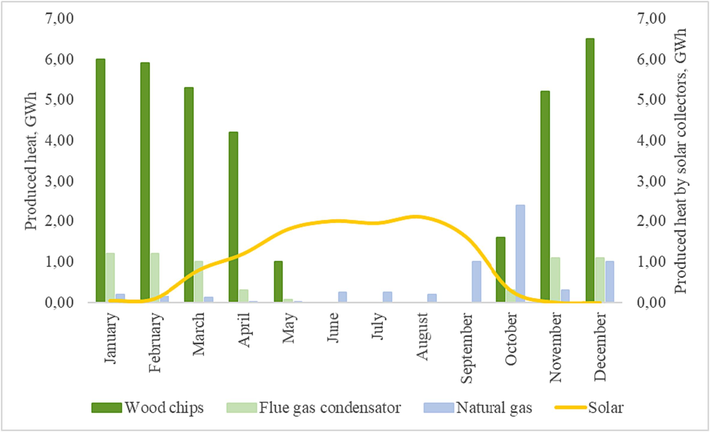
Heat production by fuel types in 2020.
The total installed heat capacity is 35.18 MW, the provided heat energy quantity to consumers is 60,000 MWh/year, the total length of the heat distribution system is 20.6 km with heat losses only – 10.2 % (Siltums, 2021). With solar energy produced by field of solar thermal collectors is planned to cover mainly summer hot water consumption and will partly contribute in spring and autumn. Fig. 3 presents the actual heat production data by fuels in 2020 (Polikarpova et al., 2021).
As the data show, the solar fraction index, or approximately 20 % of heat energy consumption, is covered by solar heat energy. This can be explained by the short-term storage of solar energy. As world practice proves, seasonal heat energy accumulators are able to raise the solar fraction of heat energy above 90 % (DLCS, xxxx).
2.1 Current situation of district heating in Latvia
As Latvia is located in North latitudes, huge resources - over the 56 % are consumed of the country's total energy consumption to cover needs of heating. The heating season varies from 192 to 206 days depending on the region. Average air temperature for coldest five days could reach −24,6 ℃ (Cabinet of Ministers Republic of Latvia, 2019). As 638 boiler houses and 160 CHP operate in Latvia, 70 % of all heat consumption is provided by district heating systems (DHS), thus ranking third in Europe by number of customers connected to DHS (The Ministry of Economics Republic of Latvia PricewaterhouseCoopers Ltd and Institute of Physical Energetics, 2012).
According to Eurostat data 20.55 % from all fuel consumed for heating and cooling is RES based. Latvia ranks third in Europe after Iceland and Lithuania in terms of population (%), which is provided with district heating (Latvian Ministry of Economics, 2020). The average heat losses in heat supply transmission and distribution networks in 2020 reached 11,3%. In Latvia, the demand for heat is significantly different depending on climatic conditions (winter periods).
Wood biomass is the most important local fuel used in Latvia for both district and local heating, but especially in individual heat supply. Most of the heat energy produced in district heating systems (DHS) is produced in Riga (capital of Latvia), of which 90 % is produced in high-efficiency cogeneration. According to Eurostat data the share of energy produced from RES in Latvian heat supply has increased from 40.7 % in 2010 to 57.8 % in 2019 (“Energy.”, 2021). Over the last 15 years, heat pumps, solar collectors, micro-cogeneration systems have as well gained popularity, as they have proven to be beneficial local heating technologies and technical possibilities in terms of the thermal comfort of passive houses (Kostenko et al., 2016). Independence of energy supply and energy efficiency are currently the most important issues that need urgent and special attention (Krizmane et al., 2016).
According to the definition of 4GDH, heat energy must be fed into more energy efficient buildings. The aim of changes and clarifications made in Latvian construction standard (in force since January 1, 2020) is to improve the quality of projects and thus to improve the physical parameters of the buildings. The requirements for the minimum permissible level of energy performance of buildings have been strengthened. Nowadays prediction of buildings’ energy consumption plays an important role in sustainable energy planning (Prozuments, 2020; Levsev et al., 2019). According to assessment of thermal comfort level in renovated and non-renovated buildings (Zajacs and Borodiņecs, 2019), transmission heat losses in renovated buildings reduced by approximately 35 %.
2.2 Sensible seasonal thermal energy storage selection
The reviewed studies described four types of TES solutions: hot water, gravel water, aquifer, and borehole thermal energy storages. The hot-water TES and aquifer TES are a types of sensible water heat storage; borehole TES is sensible solid storage and gravel water TES is a mix of sensible solids and liquids storage (Socaciu, 2011). In Latvia, there are very high groundwater-bearing layers, starting from a depth of a few centimeters (Latvian Environment Geology, xxxx), therefore this fact affects the choice of the seasonal accumulator. Also, the choice is influenced by installation costs, which can vary several times for different technologies (Doczekal, 2019; Guerra et al., 2020). We chose the ground hot-water thermal energy storage as potentially the simplest and cheapest solution.
3 Methods
Future perspectives in district heating plants will be considered in the article using the example of Latvia. For these purposes, the solar system with TES model has been created in TRNSYS software to assess possible effectiveness of increasing the share of solar energy in the total heat consumption of the city in Latvian climate conditions.
3.1 System modelling in TRNSYS
Using a solar collector field together with a short-term heat storage system can achieve Solar Fraction (SF) 10–20 % of the total system energy balance, which is an effective solution to reduce fossil fuel use and CO2 emissions (Novo et al., 2010). Solar collector systems are valued mainly on the basis of the value of the solar fraction, which is the amount of heat in the total heat balance of the solar system. The SF is calculated according to the (Eq. (1) (Hesaraki et al., 2015):
The maximum energy storage capacity of a heat storage system shall be calculated using the following (Eq. (2) (Sorknæs, 2018):
As can be seen from the equation (Eq. (3), it is necessary to know the area of solar collector’s field, but assuming different RVA values, it is possible to find the volume of the heat storage system.
One of the most important results of effective storage system is thermal insulation. If large-scale TES systems are not sufficiently insulated, they experience significant heat loss (Ochs et al., 2020). Polyurethane, glass wool, expanded polystyrene (EPS), expanded glass, and extruded polystyrene (XPS) are commonly used as thermal insulation materials for the storage system (Khoukhi et al., 2021; Dahash et al., 2019; Yoo et al., 2021).
The simulation of the storage system was performed using the modeling program TRNSYS (Transient System Simulation Tool). Before the simulation, the following input data were entered into the program: heat consumption, solar field parameters (including solar collector orientation and angle, heat carrier characteristics), heating system flow and return temperature, weather conditions. To create the simulation, a model was created by the TRNSYS software that included the field of the solar collectors together with the TES. The system model will demonstrate the importance of TES (charging and discharging) in stabilizing the discrepancy between energy production and demand. It will also be ascertained whether there is a surplus of energy produced by solar collectors’ field which could be accumulated in a seasonal energy storage. The model is shown in Fig. 4.
TRNSYS model.
3.2 TRNSYS model validation
Experimental validation of the solar system with TES performed to ensure that the simulation results would reflect reality. By monitoring the city's energy consumption and solar system energy production data, experimental data collected for a year, which used for simulation. Outdoor temperature and data of global radiation were used for simulations and model validation. Due to the available data, the annual period compared by month (Fig. 5).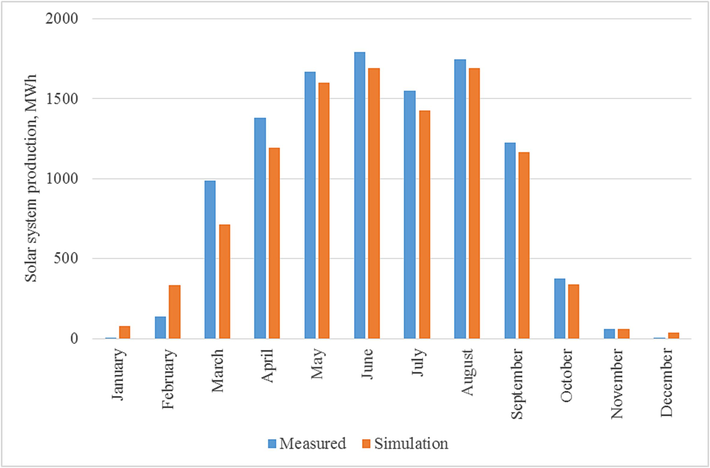
Monthly solar system production validation.
In the case of the solar thermal plant production, an overall difference of 4.53 % has been obtained. The city demand of the modeled solar district heating system was also calculated in the TRNSYS simulation, obtaining difference only 1,3 %. On the basis of the results extracted, could be conclude that the TRNSYS model is reliable.
4 Results and discussion
The simulation results were validated with real system operation results, which are currently available for two full year (with a full heating seasons). Analyzing the publicly available Salaspils siltums Ltd. data on the heat consumed by Salaspils city and the energy produced from solar collectors it is determined that the contribution of solar heat to the system varies depending on the weather conditions and the intensity of the sun during a given period. The total amount of heat delivered to the end-users in 2019 was 51,673.05 MWh and in 2020 53,219.95 MWh. The analyzed data shows that solar energy system accounted for 14.7 % (2019) and 20.5 % (2020) of all energy produced, while the remaining 85.3 % and 79.5 % respectively was additionally produced using a woodchip boiler.
The heat energy demand and data on the heat carrier flow per year per hour were entered into the model. The heat carrier flow is calculated according to the following equation (Eq. (4) (Joudi and Farhan, 2014):
The model not only entered heat demand data, but also calculated the flow rate for each hour.
Data on city’s heat consumption and solar systems with TES contribution for 2019 and 2020 are summarized below and shows the simulation results, the system was simulated with a TES volume 8000 m3 (see Table 1).
Real data
Simulation results
Year
2020
2019
The contribution of solar system, %
Months
City consumption, MWh
Produced from the solar system, MWh
The contribution of solar system, %
City consumption, MWh
Produced from the solar system, MWh
The contribution of solar system, %
January
7524,83
6,2
0,08
9733,3
104,1
1
1,07
February
7234,03
138
1,91
6897,4
318,0
3,2
4,61
March
7000,97
989
14,13
6871,8
698,2
9,98
10,16
April
4842,79
1383
28,56
3720,6
916,8
25,32
24,64
May
1981,77
1666
84,07
1509,3
1142,8
76,15
75,72
June
1403,32
1791
127,63
1220,0
1120,8
92,36
91,87
July
1447,7
1550
107,07
1203,6
1186,8
99,26
98,60
August
1418,81
1745
122,99
1329,2
1024,0
79,06
77,04
September
1510,31
1228
81,31
1564,3
672,8
45,63
43,01
October
3747,22
374
9,98
4116,7
373,4
11,07
9,07
November
6248,11
59
0,94
6141,9
1,8
0,06
0,03
December
8860,09
4
0,05
7334,9
29,3
0,5
0,4
Total:
53219,95
10933,2
20,54
51643,05
7588,8
14,87
36.35
Looking at Table 1, it can be concluded that the highest contribution of solar heat is in the summer months, in June and July, when there is the highest solar radiation and the lowest heat energy consumption, only for domestic hot water supply. The simulation results shows that the total heat contribution of the solar system to the existing system with a surface storage tank is 36.35 %, which means that the heat produced by solar collectors could provide almost 40 % of the total annual heat demand.
As can be seen, the simulation data differs from the real average values by more than 2 times, this is because during the simulation the average data on the city's heat energy consumption for the previous 5 years were used and due to the warm winter seasons the city consumption during the heating period was lower. The planned contribution of solar heat does not always coincide with the actual contribution of heat, which is related to changes in heat demand and the return temperature of the heat carrier. According to the calculations, the surface storage tank could theoretically accumulate 700 MWh which would be enough for city end-users connected to DHS for the summer season to receive hot water for two weeks, it was also used in the simulation plant.
To test solar system with TES operating performance in city DHS performed simulations of increasing TES volume. Analyzing the simulation results, it was found that the contribution of the solar system is almost unchanged. Increasing the TES volume to 97500 m3 concludes that the contribution of the solar system can only increase to 39.7 %, and given these results, it is clear that the TES with volume 8000 m3 is the optimal solution for current heat consumption and heat production. Taking into account the results of the simulation, it can be concluded that in the period from May to September, when heat energy is not consumed for heating purposes, there is almost no surplus heat energy, therefore it is not possible to create heat energy savings. The full amount of heat produced by solar collectors is passed on to consumers.
The simulations were performed to test whether there is a potential for this type of system in Latvian climatic conditions, increasing the solar collectors field area. It is concluded from this assumption that the surplus energy produced by solar collectors will also increase, then the TES system would operate more efficiently. To test this assumption, a TRNSYS model was developed in which the area of solar collectors was tripled and the theoretical area of 65,016 m2 was calculated instead of the actual area of 21,672 m2. The total contribution of solar heat to the system according to the simulation results is 51.36 %. As the area of solar collectors increases to 65,016 m2, the amount of heat produced also increases and a surplus of heat is generated during the summer months. As can be seen in the graph (Fig. 6), the heat energy curve produced from May to August exceeds the Salaspils city heat energy consumption (taken for 2020) curve, so the surplus can be accumulated in the TES.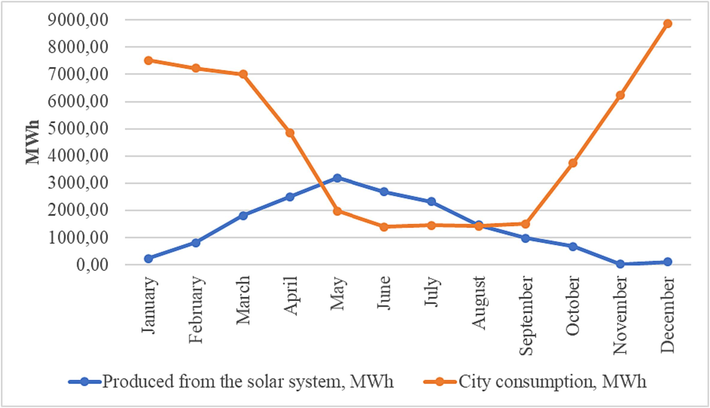
Heat energy consumption and produced heat, MWh.
According to the simulation results, increasing the contribution of solar heat by increasing the storage tank volume at the existing solar collector field area of 21.672 m2 and the theoretical simulated area of 65.016 m2. Analyzing the data that were simulated during the year, it can be seen that the results of the contribution of solar heat differ markedly after the area of solar collector field was increased. The total contribution of solar heat almost doubled when the area of solar collectors field was 65,016 m2. It can be concluded that in the case of an area of 21 672 m2, the total heat contribution increased by more than 3 % as the volume of the TES increased - from 36.35 % to 39.7 %, but if the area was 65,016 m2 by ∼ 17 % - from 51.36 % to 68.26 %.
5 Conclusions
Latvian best practice project shows also how the solar collector system can be successfully integrated into district heating system under local climate conditions; demonstrate the successful use of thermal energy storage. The TES can increase the district heating system flexibility and provide greater security by storing heat energy. Real operational data show that the heat produced by solar collector system with TES per year will cover up to 20 % (10933,2 MWh) of the heating demand in Salaspils city. In the period from May to September, almost completely cover the heat consumption of the city. Increasing solar collector field area system will cover up to 50 % (7980 MWh) of the heating demand and from May to August system produced the energy surplus which can be accumulated in the TES.
Another important parameter that can increase solar system contribution is to increase the energy efficiency of heating networks and buildings by renovation issues served by the heating supply company.
Although no specific strategy or specific challenge plan has been developed for Latvian district heating sector, it still is an important part of energy efficiency and energy planning documents. The 4GDH concept aims to facilitate energy management through a smart energy control system. The system would use new technologies, including heat meters, new management and monitoring capabilities using a new generation of Internet infrastructure. The 4GDH network aims to remove fluctuations and uncertainties between supply and demand, reduce heat losses, improve overall efficiency and network stability.
In terms of implementation, research suggests that economic incentives and regulatory simplification need to be provided, both nationally and internationally, in order to identify and introduce better green transition solutions for 4GDH.
Acknowledgment
This work has been supported by: ERA-NET-SES “Deployment of Smart Renewable Energy Communities” (DoRES); the European Regional Development Fund within the Activity 1.1.1.2 “Post-doctoral Research Aid” of the Specific Aid Objective 1.1.1 “To increase the research and innovative capacity of scientific institutions of Latvia and the ability to attract external financing, investing in human resources and infrastructure” of the Operational Programme “Growth and Employment” (No.1.1.1.2/VIAA/4/20/661).
Declaration of Competing Interest
The authors declare that they have no known competing financial interests or personal relationships that could have appeared to influence the work reported in this paper.
References
- “Energy.” 2021, [Online]. Available: https://ec.europa.eu/eurostat/web/energy/data/shares.
- “Urban Europe — statistics on cities, towns and suburbs — patterns of urban and city developments,” 2023. [Online]. Available: https://ec.europa.eu/eurostat/statistics-explained/index.php?title=Archive:Urban_Europe_—_statistics_on_cities,_towns_and_suburbs_—_patterns_of_urban_and_city_developments&oldid=298141.
- Impact of load structure variation and solar thermal energy integration on an existing district heating network. Applied Thermal Engineering. 2013;50, no. 2
- [CrossRef] [Google Scholar]
- 5th generation district heating and cooling systems: A review of existing cases in Europe. Renewable and Sustainable Energy Reviews. 2019
- [CrossRef] [Google Scholar]
- Cabinet of Ministers Republic of Latvia, Latvian building code LBN 003-19 “Building climatology.” 2019.
- European Commission, 2030 climate & energy framework - Climate Action. 2018.
- European Commission, “2050 long-term strategy - Climate Action,” 2050 Long-Term Strategy, 2018. .
- Advances in seasonal thermal energy storage for solar district heating applications: A critical review on large-scale hot-water tank and pit thermal energy storage systems. Applied Energy. 2019
- [CrossRef] [Google Scholar]
- DLCS, “Drake Landing Solar Community.” https://www.dlsc.ca/.
- C. Doczekal, “Fact Sheet: Heat Storages,” Güssing, 2019. [Online]. Available: https://tracer-h2020.eu/wp-content/uploads/2019/10/TRACER_D2.1-Heat-Storages.pdf.
- B. Gaujena, A. Borodinecs, J. Zemitis, and A. Prozuments, “Influence of building envelope thermal mass on heating design temperature,” in IOP Conference Series: Materials Science and Engineering, 2015, vol. 96, no. 1, doi: 10.1088/1757-899X/96/1/012031.
- The value of seasonal energy storage technologies for the integration of wind and solar power. Energy Environ. Sci.. 2020;13(7):pp.
- [CrossRef] [Google Scholar]
- Optimizing the utilization of excess heat for district heating in a chipboard production plant. Case Stud. Therm. Eng.. 2021;25
- [CrossRef] [Google Scholar]
- Seasonal thermal energy storage with heat pumps and low temperatures in building projects - A comparative review. Renewable and Sustainable Energy Reviews. 2015;43
- [CrossRef] [Google Scholar]
- Greenhouse heating by solar air heaters on the roof. Renewable Energy. 2014;72
- [CrossRef] [Google Scholar]
- Impact of dynamic thermal conductivity change of EPS insulation on temperature variation through a wall assembly. Case Stud. Therm. Eng.. 2021;25
- [CrossRef] [Google Scholar]
- Key Criteria Across Existing Sustainable Building Rating Tools. Energy Procedia. 2016;96
- [CrossRef] [Google Scholar]
- Latvian Environment Geology and Meteorology Centre, “Underground waters in Latvia.” https://videscentrs.lvgmc.lv/lapas/pazemes-udeni-latvija.
- Latvia’s National Energy and Climate Plan. 2020;2021–2030:176.
- Increasing the heat transfer efficiency of sectional radiators in building heating systems. Mag. Civ. Eng. 2019
- [CrossRef] [Google Scholar]
- Review of seasonal heat storage in large basins: Water tanks and gravel-water pits. Applied Energy. 2010;87(2):pp.
- [CrossRef] [Google Scholar]
- F. Ochs, A. Dahash, A. Tosatto, and M. Bianchi Janetti, “Techno-economic planning and construction of cost-effective large-scale hot water thermal energy storage for Renewable District heating systems,” Renew. Energy, vol. 150, 2020, doi: 10.1016/j.renene.2019.11.017.
- I. Polikarpova, R. Kakis, I. Pakere, and D. Blumberga, “Optimizing large-scale solar field efficiency: Latvia case study,” Energies, vol. 14, no. 14, 2021, doi: 10.3390/en14144171.
- D. Prozuments, A., Borodinecs, A., Odineca, T., & Nemova, “Long-term buildings’ space heating estimation method,” 2020, doi: 10.1007/978-3-030-42351-3_47.
- BIG Solar Graz: Solar District Heating in Graz - 500,000 m2 for 20% Solar Fraction. Energy Procedia. 2016;91
- [CrossRef] [Google Scholar]
- Salaspils Siltums, “Salaspils Siltums in numbers,” 2021. https://salaspilssiltums.lv/en/salaspils-siltums-in-numbers/.
- Seasonal sensible thermal energy storage solutions. Leonardo Electron. J. Pract. Technol.. 2011;10(19)
- [Google Scholar]
- Simulation method for a pit seasonal thermal energy storage system with a heat pump in a district heating system. Energy. 2018;152
- [CrossRef] [Google Scholar]
- The Ministry of Economics Republic of Latvia PricewaterhouseCoopers Ltd and Institute of Physical Energetics, “High efficiency cogeneration and efficient centralized heat supply and cooling use potential comprehensive evaluation and cost and benefit analysis according to the Directive 2012/27/EU requirements,” Riga, 2016. [Online]. Available: https://energy.ec.europa.eu/system/files/2016-03/Art%252014%25281%2529%2520assessmentLatvia_0.pdf.
- Large-scale solar district heating plants in Danish smart thermal grid: Developments and recent trends. Energy Conversion and Management. 2019
- [CrossRef] [Google Scholar]
- M. R. et al Tobias Fleiter, Jan Steinbach, “Mapping and Analysis of the Current and Future (2020-2030) heating/cooling fuel deployment (fossils/renewables),” European Commission Directorate-General For Energy, 2016. https://www.isi.fraunhofer.de/content/dam/isi/dokumente/ccx/mapping-eu/Mapping-HC-Final-Report-WP2.pdf.
- A. Tonhammar, “Solar District Heating: The potential of a large scale solar district heating facility in Stockholm,” Uppsala University, 2014.
- U. Koldo and et al Torrens Ignacio, “District heating and cooling solution booklet,” 2020. [Online]. Available: https://www.euroheat.org/wp-content/uploads/2020/03/scis_solution_booklet_district_heating_and_cooling.pdf.
- Solar District Heating in East Germany-Transformation in a Cogeneration Dominated City. Energy Procedia. 2015;70
- [CrossRef] [Google Scholar]
- Dimensioning of Solar Thermal Systems for Multi-Family Buildings in Lithuania: an Optimisation Study. J. Sustain. Archit Civ. Eng.. 2015;11(2):pp.
- [CrossRef] [Google Scholar]
- W. Weiss and M. Spörk-Dür, “Solar Heat Worldwide 2018. Global Market Development and Trends in 2017. Detailed Market Figures 2016,” IEA Sol. Heat. Cool. Program., 2018.
- Performance of the hygrothermal behavior of the CLT wall using different types of insulation; XPS, PF board and glass wool. Case Stud. Therm. Eng.. 2021;24
- [CrossRef] [Google Scholar]
- Assessment of development scenarios of district heating systems. Sustainable Cities and Society 2019
- [CrossRef] [Google Scholar]







